Seasonal Variations of Dissolved Iron Concentration in Active Layer and Rivers in Permafrost Areas, Russian Far East
Abstract
1. Introduction
2. Materials and Methods
2.1. Study Site
2.2. Soil Pore Water Sampling and Soil Characteristic Measurement along a Transect
2.3. River Water Sampling and Hydrological Observation
2.4. Chemical Analyses
3. Results
3.1. Seasonal Variations in dFe and DOC Concentrations in Sofron River and Large Rivers
3.2. Organic Carbon Contents and Weight Moisture Contents of Soils along a Transect
3.3. Seasonal Soil Thaw Dynamics in Different Terrain Types
3.4. Seasonal Changes in dFe Concentrations in Soil Pore Waters along a Transect
4. Discussion
4.1. dFe Production in Uppermost Soils and Its Discharge into Rivers during Snowmelt Season
4.2. Seasonal Changes in Iron Behavior in Thawed Active Layer after Snowmelt Season
4.3. Seasonal Changes in dFe Discharge Mechanism Associated with Downward Shift of Flow Path after Snowmelt Season
5. Conclusions
- In snowmelt season, high dFe production occur in the waterlogged surface soils, which leads to the largest terrestrial dFe transport in the year.
- Summer rainfall not only increases in dFe and DOC concentrations in river but probably has the effect of promoting dFe production in subsurface soils of permafrost wetlands in valley area.
- Overall, permafrost wetlands in valley areas are important environment in which dFe production occurs in response to seasonal hydrological events (spring snowmelt and summer rainfall) and soil thaw depth, and play a significant role in supplying dFe and DOC to rivers.
Author Contributions
Funding
Acknowledgments
Conflicts of Interest
References
- Sunda, W.G. Feedback interactions between trace metal nutrients and phytoplankton in the ocean. Front. Microbiol. 2012, 3, 204. [Google Scholar] [CrossRef] [PubMed]
- Martin, J.H.; Fitzwater, S.E. Iron deficiency limits phytoplankton growth in the North-east Pacific subarctic. Nature 1988, 336, 403–405. [Google Scholar] [CrossRef]
- Martin, J.H.; Gordon, R.M.; Fitzwater, S.E.; Broenkow, W.W. Vertex: Phytoplankton/iron studies in the Gulf of Alaska. Deep Sea Res. Part A 1989, 36, 649–680. [Google Scholar] [CrossRef]
- Martin, J.H.; Gordon, R.; Fitzwater, S.E. Iron in Antarctic waters. Nature 1990, 345, 156–158. [Google Scholar] [CrossRef]
- Martin, J.H.; Coale, K.H.; Johnson, K.S.; Fitzwater, S.E.; Gordon, R.M.; Tanner, S.J.; Hunter, C.N.; Elrod, V.A.; Nowick, J.L.; Coley, T.L.; et al. Testing the iron hypothesis in ecosystems of the equatorial Pacific Ocean. Nature 1994, 371, 123–129. [Google Scholar] [CrossRef]
- Price, N.M.; Ahner, B.A.; Morel, F.M.M. The equatorial Pacific Ocean: Grazer-controlled phytoplankton populations in an iron-limited ecosystem. Limnol. Oceanogr. 1994, 39, 520–534. [Google Scholar] [CrossRef]
- Takeda, S.; Obata, H. Response of equatorial Pacific phytoplankton to subnanomolar Fe enrichment. Mar. Chem. 1995, 50, 219–227. [Google Scholar] [CrossRef]
- Bruland, K.W.; Lohan, M.C. Controls of Trace Metals in Seawater. Treatise Geochem. 2003, 6, 23–47. [Google Scholar]
- Matsunaga, K.; Nishioka, J.; Kuma, K.; Toya, K.; Suzuki, Y. Riverine input of bioavailable iron supporting phytoplankton growth in Kesennuma Bay (Japan). Water Res. 1998, 32, 3436–3442. [Google Scholar] [CrossRef]
- Laglera, L.M.; Vandenberg, C.M.G. Evidence for geochemical control of iron by humic substances in seawater. Limnol. Oceanogr. 2009, 54, 610–619. [Google Scholar] [CrossRef]
- Nishioka, J.; Nakatsuka, T.; Ono, K.; Volkov, Y.N.; Scherbinin, A.; Shiraiwa, T. Quantitative evaluation of iron transport processes in the Sea of Okhotsk. Prog. Oceanogr. 2014, 126, 180–193. [Google Scholar] [CrossRef]
- Boyle, E.A.; Edmond, J.M.; Sholkovitz, E.R. The mechanism of iron removal in estuaries. Geochim. Cosmochim. Acta 1977, 41, 1313–1324. [Google Scholar] [CrossRef]
- Morel, F.M.M.; Kustka, A.B.; Shaked, Y. The role of unchelated Fe in the iron nutrition of phytoplankton. Limnol. Oceano. 2008, 53, 400–404. [Google Scholar] [CrossRef]
- Kranzler, C.; Lis, H.; Shaked, Y.; Keren, N. The role of reduction in iron uptake processes in a unicellular, planktonic cyanobacterium. Environ. Microbiol. 2011, 13, 2990–2999. [Google Scholar] [CrossRef]
- Morrissey, J.; Bowler, C. Iron utilization in marine cyanobacteria and eukaryotic algae. Front. Microbiol. 2012, 3, 1–13. [Google Scholar] [CrossRef] [PubMed]
- Krachler, R.; Jirsa, F.; Ayromlou, S. Factors influencing the dissolved iron input by river water to the open ocean. Biogeosciences 2005, 2, 311–315. [Google Scholar] [CrossRef]
- Krachler, R.; Krachler, R.F.; Von Der Kammer, F.; Süphandag, A.; Jirsa, F.; Ayromlou, S.; Hofmann, T.; Keppler, B.K. Science of the Total Environment Relevance of peat-draining rivers for the riverine input of dissolved iron into the ocean. Sci. Total Environ. 2010, 408, 2402–2408. [Google Scholar] [CrossRef] [PubMed]
- Klunder, M.B.; Bauch, D.; Laan, P.; De Baar, H.J.W.; Van Heuven, S.; Ober, S. Dissolved iron in the Arctic shelf seas and surface waters of the central Arctic Ocean: Impact of Arctic river water and ice-melt. J. Geophys. Res. Ocean. 2012, 117, 1–18. [Google Scholar] [CrossRef]
- Suzuki, K.; Hattori-Saito, A.; Sekiguchi, Y.; Nishioka, J.; Shigemitsu, M.; Isada, T.; Liu, H.; McKay, R.M.L. Spatial variability in iron nutritional status of large diatoms in the Sea of Okhotsk with special reference to the Amur River discharge. Biogeosciences 2014, 11, 2503–2517. [Google Scholar] [CrossRef]
- Shiraiwa, T. “Giant Fish-Breeding Forest”: A New Environmental System Linking Continental Watershed with Open Water. In The Dilemma of Boundaries; Taniguchi, M., Shiraiwa, T., Eds.; Springer: Tokyo, Japan, 2012; pp. 73–85. [Google Scholar]
- Pan, X.F.; Yan, B.X.; Yoh, M. Effects of land use and changes in cover on the transformation and transportation of iron: A case study of the Sanjiang Plain, Northeast China. Sci. China Earth Sci. 2011, 54, 686–693. [Google Scholar] [CrossRef]
- Shamov, V.V.; Onishi, T.; Kulakov, V.V. Dissolved Iron Runoff in Amur Basin Rivers in the Late XX Century. Water Resour. 2014, 41, 201–209. [Google Scholar] [CrossRef]
- Gu, B.; Schmitt, J.; Chen, Z.; Liang, L.; McCarthy, J.F. Adsorption and desorption of natural organic matter on iron oxide: Mechanisms and models. Environ. Sci. Technol. 1994, 28, 38–46. [Google Scholar] [CrossRef] [PubMed]
- Gu, B.; Schmitt, J.; Chen, Z.; Liang, L.; McCarthy, J.F. Adsorption and desorption of different organic matter fractions on iron oxide. Geochim. Cosmochim. Acta 1995, 59, 219–229. [Google Scholar] [CrossRef]
- Baldock, J.A.; Skjemstad, J.O. Role of the soil matrix and minerals in protecting natural organic materials against biological attack. Org. Geochem. 2000, 31, 697–710. [Google Scholar] [CrossRef]
- Roden, E.E.; Wetzel, R.G. Kinetics of microbial Fe (III) oxide reduction in freshwater wetland sediments. Limnol. Oceanogr. 2002, 47, 198–211. [Google Scholar] [CrossRef]
- Miller, K.E.; Lai, C.T.; Friedman, E.S.; Angenent, L.T.; Lipson, D.A. Methane suppression by iron and humic acids in soils of the Arctic Coastal Plain. Soil Biol. Biochem. 2015, 83, 176–183. [Google Scholar] [CrossRef]
- Lipson, D.A.; Jha, M.; Raab, T.K.; Oechel, W.C. Reduction of iron (III) and humic substances plays a major role in anaerobic respiration in an Arctic peat soil. J. Geophys. Res. Biogeosci. 2010, 115, 1–13. [Google Scholar] [CrossRef]
- Lipson, D.A.; Zona, D.; Raab, T.K.; Bozzolo, F.; Mauritz, M.; Oechel, W.C. Water-table height and microtopography control biogeochemical cycling in an Arctic coastal tundra ecosystem. Biogeosciences 2012, 9, 577–591. [Google Scholar] [CrossRef]
- Lipson, D.A.; Raab, T.K.; Goria, D.; Zlamal, J. The contribution of Fe(III) and humic acid reduction to ecosystem respiration in drained thaw lake basins of the Arctic Coastal Plain. Glob. Biogeochem. Cycles 2013, 27, 399–409. [Google Scholar] [CrossRef]
- Herndon, E.M.; Yang, Z.; Bargar, J.; Janot, N.; Regier, T.Z.; Graham, D.E.; Wullschleger, S.D.; Gu, B.; Liang, L. Geochemical drivers of organic matter decomposition in arctic tundra soils. Biogeochemistry 2015, 126, 397–414. [Google Scholar] [CrossRef]
- Herndon, E.; Albashaireh, A.; Singer, D.; Roy, T.; Gu, B.; Graham, D. Influence of iron redox cycling on organo-mineral associations in Arctic tundra soil. Geochim. Cosmochim. Acta 2017, 207, 210–231. [Google Scholar] [CrossRef]
- Bagard, M.L.; Chabaux, F.; Pokrovsky, O.S.; Viers, J.; Prokushkin, A.S.; Stille, P.; Rihs, S.; Schmitt, A.; Dupré, B. Seasonal variability of element fluxes in two Central Siberian rivers draining high latitude permafrost dominated areas. Geochim. Cosmochim. Acta 2011, 75, 3335–3357. [Google Scholar] [CrossRef]
- Bel’chikova, N.P. Determination of humus in soil by I.V. Tyurin method. In Agrochemical Methods of Soil Studies; Sokolov, A.V., Ed.; Nauka: Moscow, Russia, 1975; pp. 56–62. (In Russian) [Google Scholar]
- Thunholm, B.; Lundln, L.; Lindell, S.; Meteorological, S. Infiltation into a Frozen Heavy Clay Soil. Hydrol. Res. 1989, 20, 153–166. [Google Scholar] [CrossRef]
- Stähli, M.; Jansson, P.E.; Lundin, L.C. Preferential water flow in a frozen soil—A two-domain model approach. Hydrol. Process. 1996, 10, 1305–1316. [Google Scholar] [CrossRef]
- Seto, M.; Akagi, T. Influence of snow on iron release from soil. Geochem. J. 2005, 39, 173–183. [Google Scholar] [CrossRef]
- Morse, J.L.; Durán, J.; Groffman, P.M. Soil Denitrification Fluxes in a Northern Hardwood Forest: The Importance of Snowmelt and Implications for Ecosystem N Budgets. Ecosystems 2015, 18, 520–532. [Google Scholar] [CrossRef]
- Rember, R.D.; Trefry, J.H. Increased concentrations of dissolved trace metals and organic carbon during snowmelt in rivers of the alaskan arctic. Geochim. Cosmochim. Acta 2004, 68, 477–489. [Google Scholar] [CrossRef]
- Andersson, K.; Dahlqvist, R.; Turner, D.; Stolpe, B.; Larsson, T.; Ingri, J.; Andersson, P. Colloidal rare earth elements in a boreal river: Changing sources and distributions during the spring flood. Geochim. Cosmochim. Acta 2006, 70, 3261–3274. [Google Scholar] [CrossRef]
- Ingri, J.; Malinovsky, D.; Rodushkin, I.; Baxter, D.C. Iron isotope fractionation in river colloidal matter. Earth Planet. Sci. Lett. 2006, 245, 792–798. [Google Scholar] [CrossRef]
- Björkvald, L.; Buffam, I.; Laudon, H.; Mörth, C.M. Hydrogeochemistry of Fe and Mn in small boreal streams: The role of seasonality, landscape type and scale. Geochim. Cosmochim. Acta 2008, 72, 2789–2804. [Google Scholar] [CrossRef]
- Iwata, Y.; Hasegawa, S.; Suzuki, S.; Nemoto, M.; Hirota, T. Effects of soil frost depth and soil temperature on downward soil water movement during snowmelt period. J. Jpn. Soc. Soil Phys. 2011, 117, 11–21. (In Japanese) [Google Scholar]
- Ågren, A.; Buffam, I.; Berggren, M.; Bishop, K.; Jansson, M.; Laudon, H. Dissolved organic carbon characteristics in boreal streams in a forest-wetland gradient during the transition between winter and summer. J. Geophys. Res. Biogeosci. 2008, 113, 1–11. [Google Scholar] [CrossRef]
- Nagao, S.; Motoki, T.; Kodama, H.; Kim, V.I.; Shesterkin, P.V.; Makhinov, A.N. Migration Behavior of Fe in the Amur River Basin. Rep. Amur Okhotsk Proj. 2007, 4, 37–48. [Google Scholar]
- Guan, J.; Yan, B.; Yuan, X. Variations of total dissolved iron and its impacts during an extreme spring flooding event in the Songhua River. J. Geochem. Explor. 2016, 166, 27–32. [Google Scholar] [CrossRef]
- Ingri, J.; Conrad, S.; Lidman, F.; Nordblad, F.; Engström, E.; Rodushkin, I.; Porcelli, D. Iron isotope pathways in the boreal landscape: Role of the riparian zone. Geochim. Cosmochim. Acta 2018, 239, 49–60. [Google Scholar] [CrossRef]
- Weber, K.A.; Achenbach, L.A.; Coates, J.D. Microorganisms pumping iron: Anaerobic microbial iron oxidation and reduction. Nat. Rev. Microbiol. 2006, 4, 752–764. [Google Scholar] [CrossRef]
- Lovley, D.R.; Coates, J.D.; Blunt-Harris, E.L.; Phillips, E.J.P.; Woodward, J.C. Humic substances as electron acceptors for microbial respiration. Nature 1996, 382, 445–448. [Google Scholar] [CrossRef]
- Benz, M.; Schink, B.; Brune, A. Humic acid reduction by Propionibacterium freudenreichii and other fermenting bacteria. Appl. Environ. Microbiol. 1998, 64, 4507–4512. [Google Scholar] [CrossRef]
- Coates, J.D.; Ellis, D.J.; Roden, E.; Gaw, K.; Blunt-Harris, E.L.; Lovley, D.R. Recovery of humics-reducing bacteria from a diversity of sedimentary environments. Appl. Environ. Microbiol. 1998, 64, 1504–1509. [Google Scholar] [CrossRef]
- Kappler, A.; Benz, M.; Schink, B.; Brune, A. Electron shuttling via humic acids in microbial iron(III) reduction in a freshwater sediment. FEMS Microbiol. Ecol. 2004, 47, 85–92. [Google Scholar] [CrossRef]
- Street, L.E.; Lessels, J.S.; Subke, J.; Tetzlaff, D.; Wookey, P.A. Redox dynamics in the active layer of an Arctic headwater catchment; examining the potential for transfer of dissolved methane from soils to stream water. J. Geophys. Res. Biogeosci. 2016, 121, 2776–2792. [Google Scholar] [CrossRef]
- Fuss, C.B.; Driscoll, C.T.; Johnson, C.E.; Petras, R.J.; Fahey, T.J. Dynamics of oxidized and reduced iron in a northern hardwood forest. Biogeochemistry 2010, 104, 103–119. [Google Scholar] [CrossRef]
- Lüdecke, C.; Reiche, M.; Eusterhues, K.; Nietzsche, S.; Küsel, K.; Schiller, F. Acid-tolerant microaerophilic Fe(II)-oxidizing bacteria promote Fe(III)-accumulation in a fen. Environ. Microbiol. 2010, 12, 2814–2825. [Google Scholar] [CrossRef] [PubMed]
- Poulton, S.W.; Canfield, D.E. Development of a sequential extraction procedure for iron: Implications for iron partitioning in continentally derived particulates. Chem. Geol. 2005, 214, 209–221. [Google Scholar] [CrossRef]
- Ågren, A.; Buffam, I.; Jansson, M.; Laudon, H. Importance of seasonality and small streams for the landscape regulation of dissolved organic carbon export. J. Geophys. Res. Biogeosci. 2007, 112, 1–11. [Google Scholar] [CrossRef]
- Prokushkin, A.S.; Pokrovsky, O.S.; Shirokova, L.S.; Korets, M.A.; Viers, J.; Prokushkin, S.G.; Amon, R.M.W.; Guggenberger, G.; McDowell, W.H. Sources and the flux pattern of dissolved carbon in rivers of the Yenisey basin draining the Central Siberian Plateau. Environ. Res. Lett. 2011, 6, 1–14. [Google Scholar] [CrossRef]
- Koch, J.C.; Runkel, R.L.; Striegl, R.; McKnight, D.M. Hydrologic controls on the transport and cycling of carbon and nitrogen in a boreal catchment underlain by continuous permafrost. J. Geophys. Res. Biogeosci. 2013, 118, 698–712. [Google Scholar] [CrossRef]
- Abesser, C.; Robinson, R.; Soulsby, C. Iron and manganese cycling in the storm runoff of a Scottish upland catchment. J. Hydrol. 2006, 326, 59–78. [Google Scholar] [CrossRef]
- Quinton, W.L.; Baltzer, J.L. The active-layer hydrology of a peat plateau with thawing permafrost (Scotty Creek , Canada). Hydrogeol. J. 2013, 21, 201–220. [Google Scholar] [CrossRef]
- Quinton, W.L.; Hayashi, M.; Carey, S.K. Peat hydraulic conductivity in cold regions and its relation to pore size and geometry. Hydrol. Process. 2008, 22, 2829–2837. [Google Scholar] [CrossRef]
- Watson, V.; Kooi, H.; Bense, V. Potential controls on cold-season river flow behavior in subarctic river basins of Siberia. J. Hydrol. 2013, 489, 214–226. [Google Scholar] [CrossRef]
- Ilina, S.M.; Poitrasson, F.; Lapitskiy, S.A.; Alekhin, Y.V. Extreme iron isotope fractionation between colloids and particles of boreal and temperate organic-rich waters. Geochim. Cosmochim. Acta 2013, 101, 96–111. [Google Scholar] [CrossRef]
- Pokrovsky, O.S.; Manasypov, R.M.; Loiko, S.V.; Krickov, I.A.; Kopysov, S.G.; Kolesnichenko, L.G.; Vorobyev, S.V.; Kirpotin, S.N. Trace element transport in western Siberian rivers across a permafrost gradient. Biogeosciences 2016, 13, 1877–1900. [Google Scholar] [CrossRef]
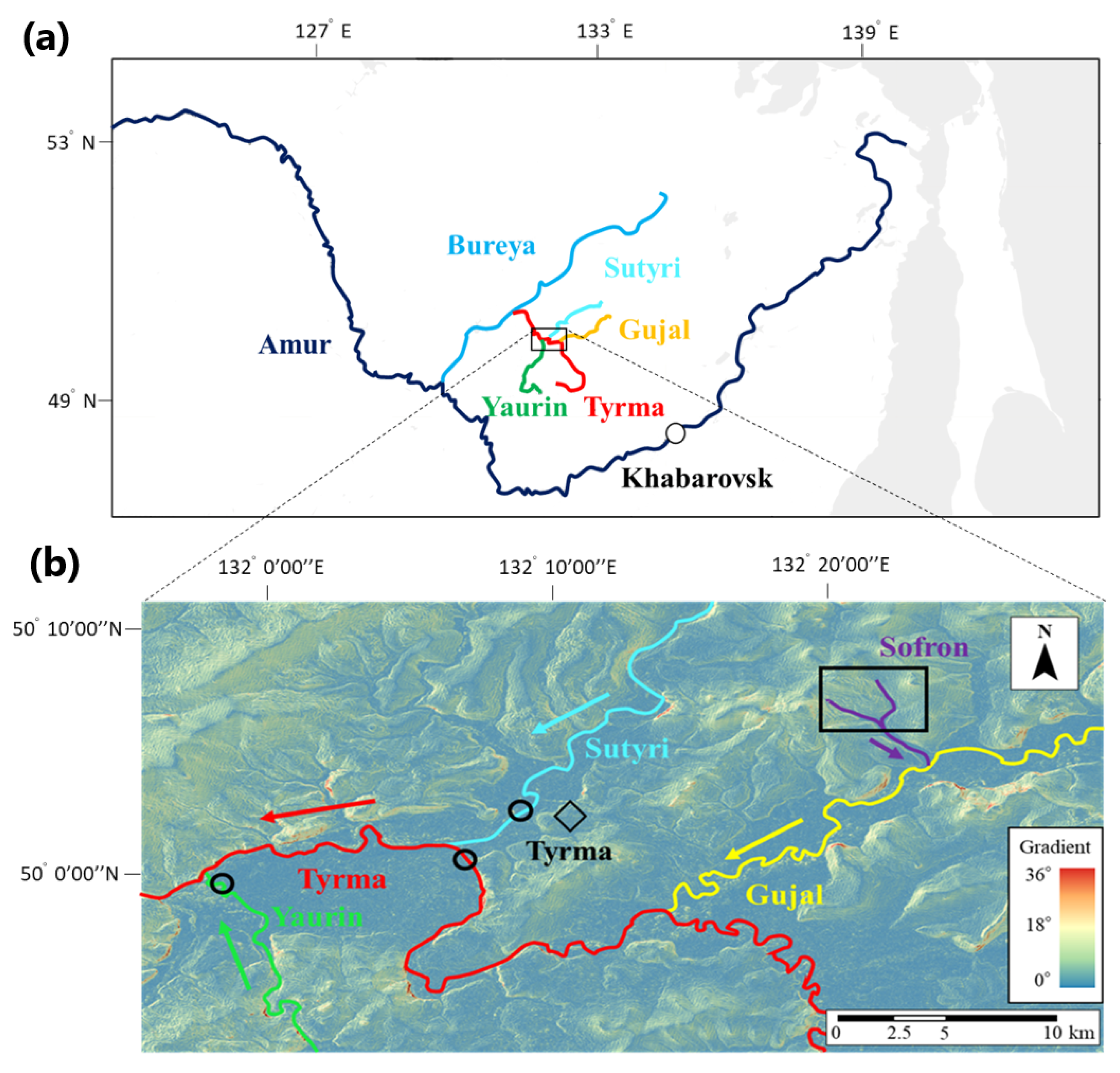
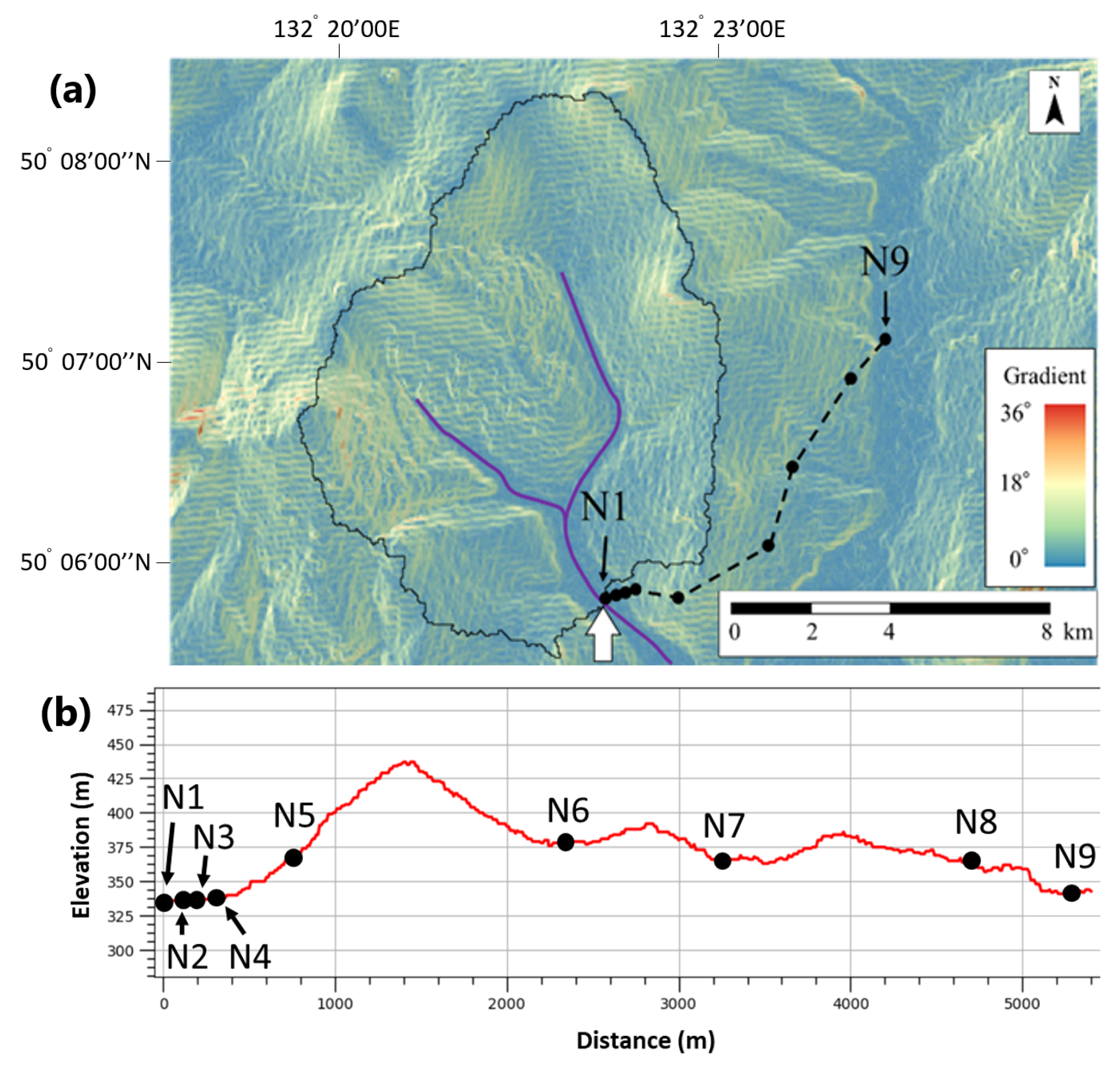
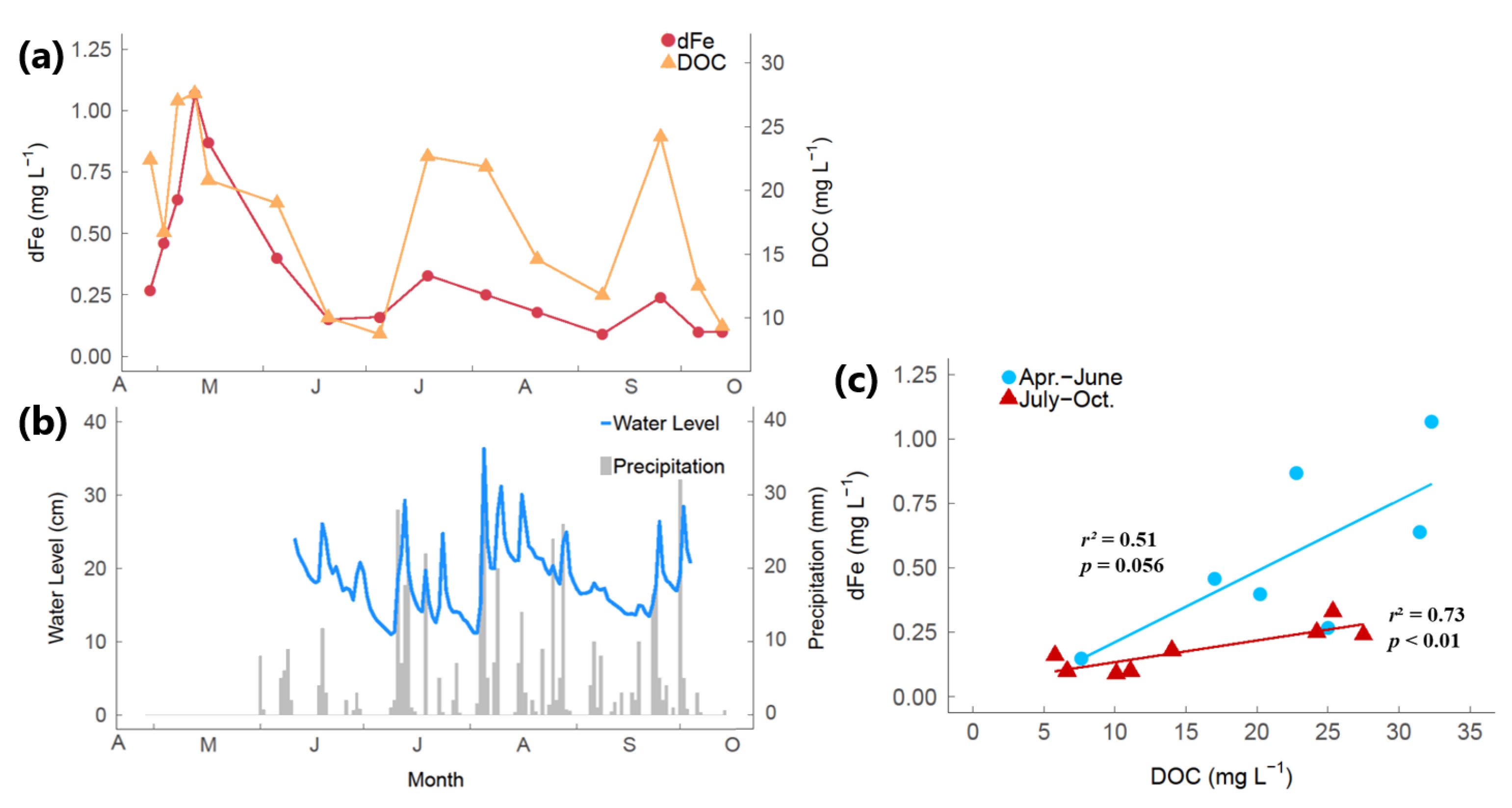
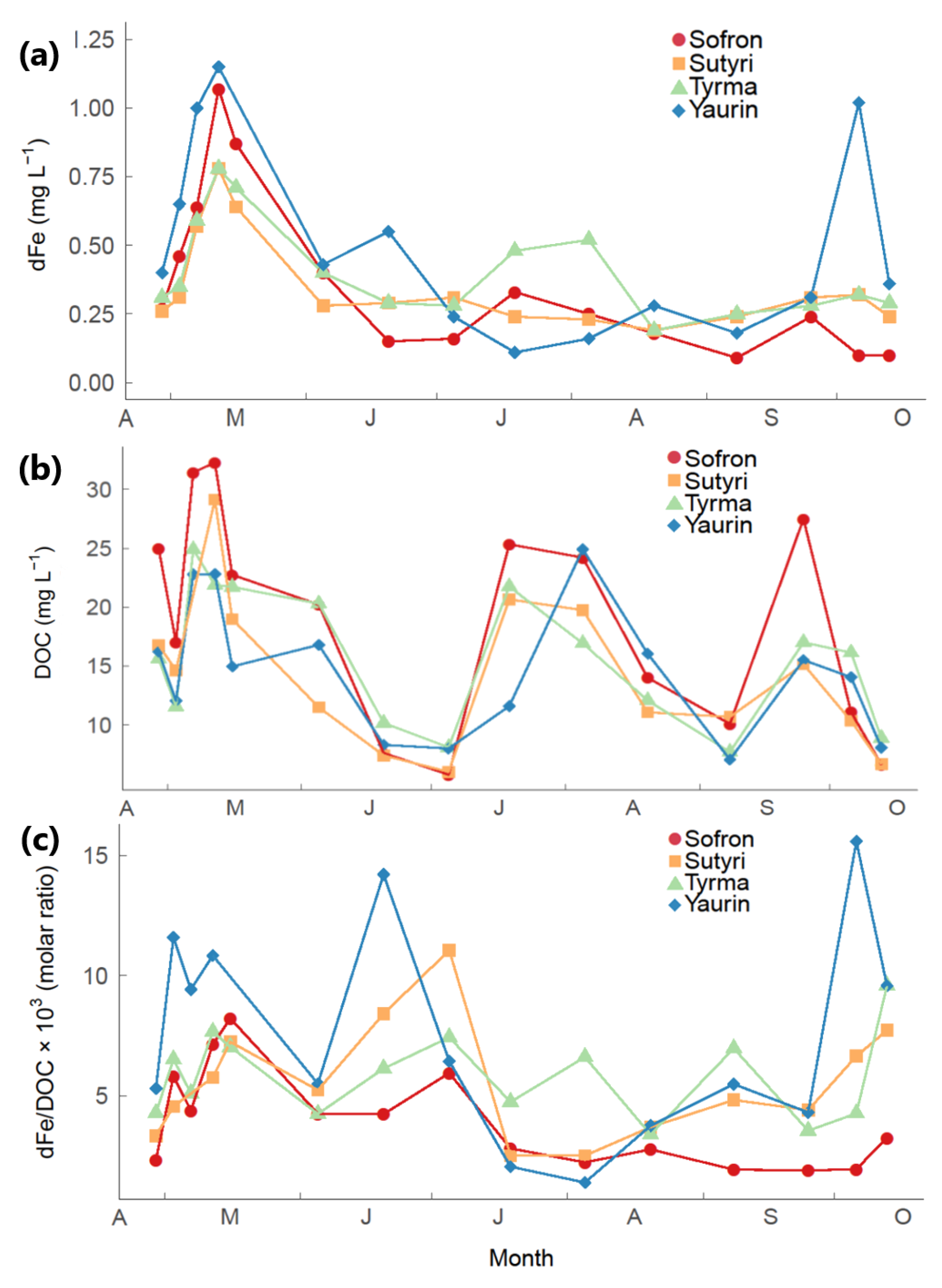

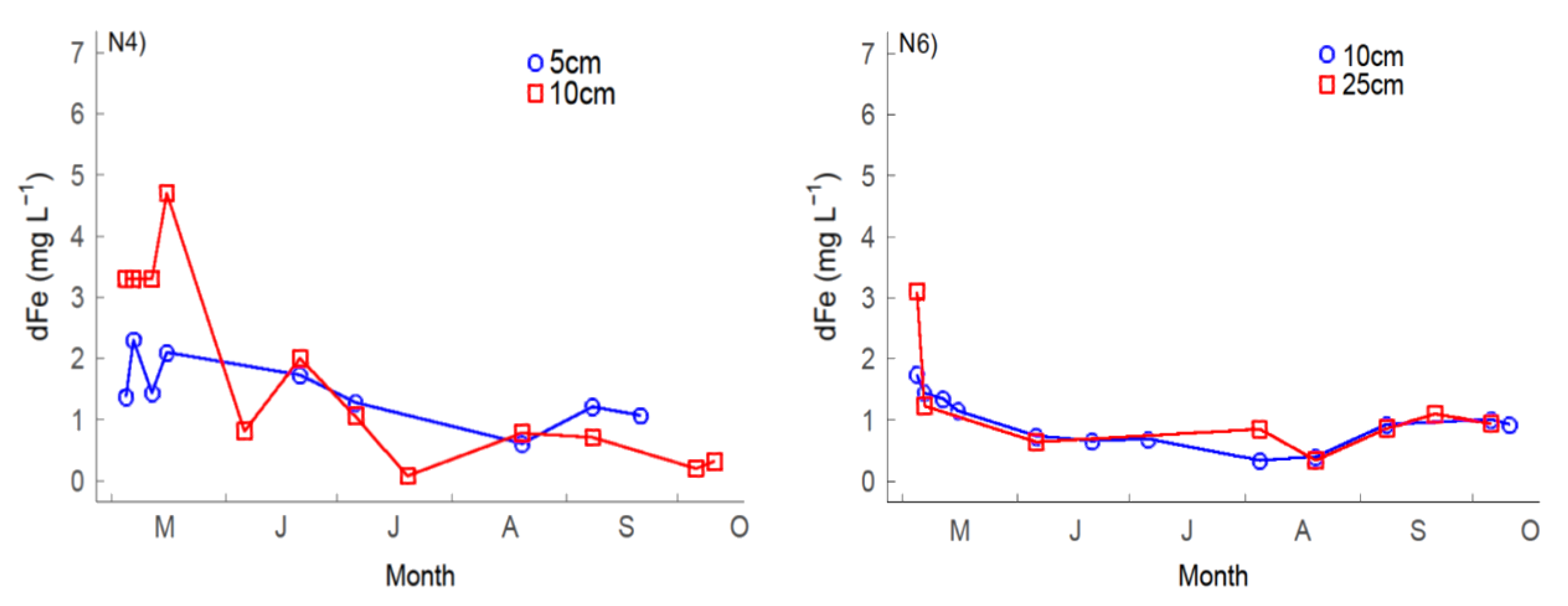
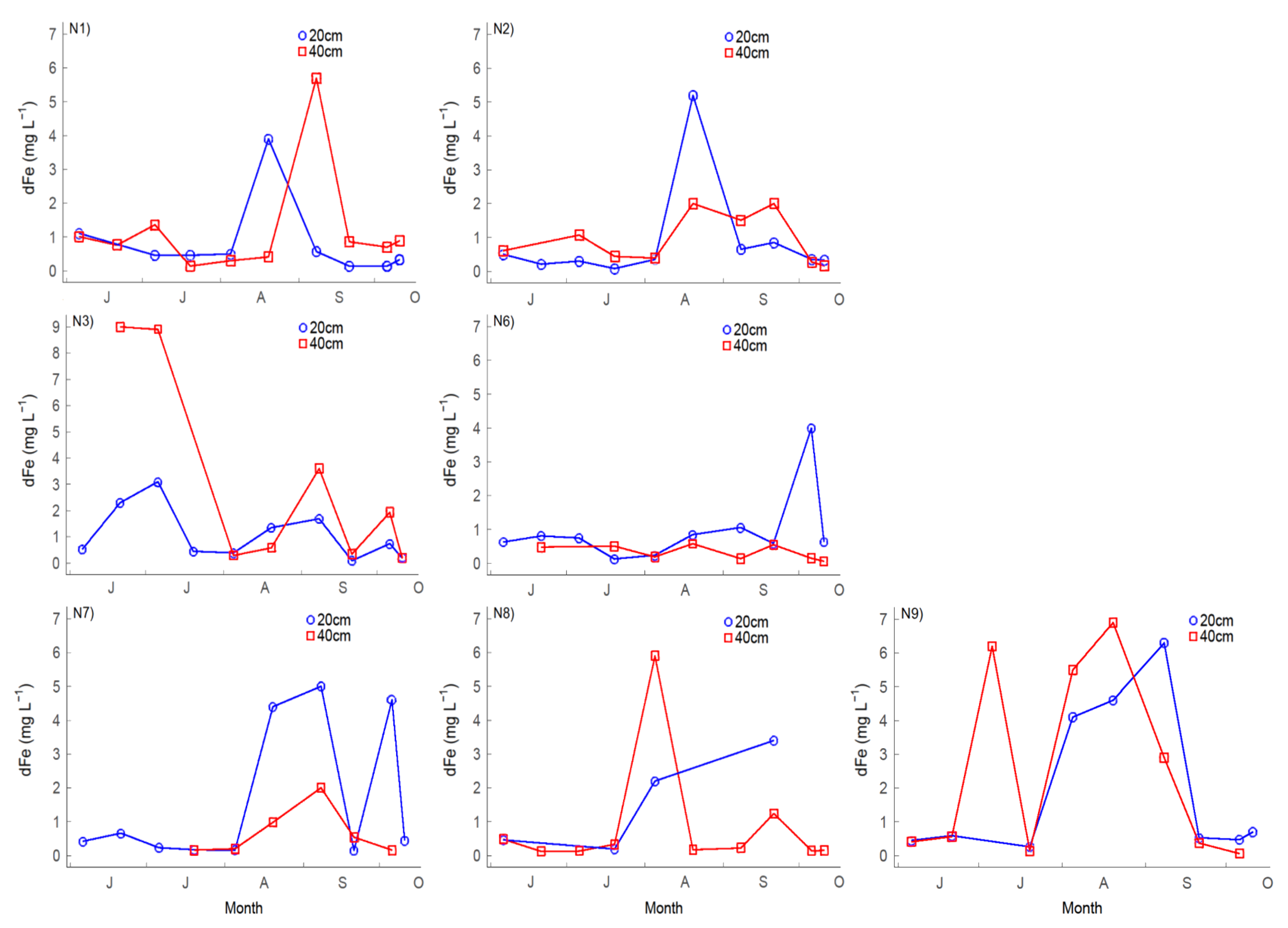
| Point Number | Terrain Type | Sampling Depth (cm) | ALT (cm) | PLT (cm) |
|---|---|---|---|---|
| N1 | Valley | 20, 40 | 64 | >64 |
| N2 | Valley | 20, 40 | 60 | >60 |
| N3 | Valley | 20, 40 | 82 | >82 |
| N4 | Boundary between valley and hillslope | 5 *, 10 * | 102 | 12 |
| N5 | Steep hillslope | 40 | No permafrost | 7 |
| N6 | Ridge | 10 *, 25 *, 20, 40 | No permafrost | 42 |
| N7 | Ridge | 20, 40 | 75 | 40 |
| N8 | Gentle hillslope | 20, 40 | 127 | 45 |
| N9 | Valley | 20, 40 | 53 | >53 |
| Point Number | Terrain Type | Organic Carbon Content (gC kg) | Weight Moisture Content (%) | ||||
|---|---|---|---|---|---|---|---|
| 0–10 cm | 10–20 cm | 20–30 cm | 0–10 cm | 10–20 cm | 20–30 cm | ||
| N1 | Valley | 405 | 451 | 331 | 92.7 | 93.0 | 89.8 |
| N2 | Valley | 478 | 403 | 474 | 99.7 | 99.0 | 98.4 |
| N3 | Valley | 411 | 311 | 100 | 99.5 | 92.1 | 90.3 |
| N4 | Boundary between valley and hillslope | 358 | 143 | 29 | 92.4 | 45.8 | 32.4 |
| N5 | Steep hillslope | 142 | 62 | 61 | 90.0 | 64.4 | 58.3 |
| N6 | Ridge | 355 | 262 | 197 | 74.3 | 75.9 | 69.3 |
| N7 | Ridge | 331 | 162 | 52 | 49.4 | 42.6 | 40.5 |
| N8 | Gentle hillslope | 48 | 248 | 23 | 68.1 | 48.7 | 38.7 |
| N9 | Valley | 144 | 293 | 297 | 99.8 | 99.5 | 78.0 |
| Depth (cm) | N1 | N4 | N6 | |
|---|---|---|---|---|
| Thawing Date | 10 | 5/24 | 4/29 | 4/18 |
| (mm/dd) | 25 | 6/15 | 5/18 | 6/5 |
| 50 | 7/1 | 7/2 | ||
| Thawing Rate | 10→25 | 0.68 | 0.79 | 0.31 |
| (cm day) | 25→50 | 0.57 | 0.93 |
© 2020 by the authors. Licensee MDPI, Basel, Switzerland. This article is an open access article distributed under the terms and conditions of the Creative Commons Attribution (CC BY) license (http://creativecommons.org/licenses/by/4.0/).
Share and Cite
Tashiro, Y.; Yoh, M.; Shiraiwa, T.; Onishi, T.; Shesterkin, V.; Kim, V. Seasonal Variations of Dissolved Iron Concentration in Active Layer and Rivers in Permafrost Areas, Russian Far East. Water 2020, 12, 2579. https://doi.org/10.3390/w12092579
Tashiro Y, Yoh M, Shiraiwa T, Onishi T, Shesterkin V, Kim V. Seasonal Variations of Dissolved Iron Concentration in Active Layer and Rivers in Permafrost Areas, Russian Far East. Water. 2020; 12(9):2579. https://doi.org/10.3390/w12092579
Chicago/Turabian StyleTashiro, Yuto, Muneoki Yoh, Takayuki Shiraiwa, Takeo Onishi, Vladimir Shesterkin, and Vladimir Kim. 2020. "Seasonal Variations of Dissolved Iron Concentration in Active Layer and Rivers in Permafrost Areas, Russian Far East" Water 12, no. 9: 2579. https://doi.org/10.3390/w12092579
APA StyleTashiro, Y., Yoh, M., Shiraiwa, T., Onishi, T., Shesterkin, V., & Kim, V. (2020). Seasonal Variations of Dissolved Iron Concentration in Active Layer and Rivers in Permafrost Areas, Russian Far East. Water, 12(9), 2579. https://doi.org/10.3390/w12092579





